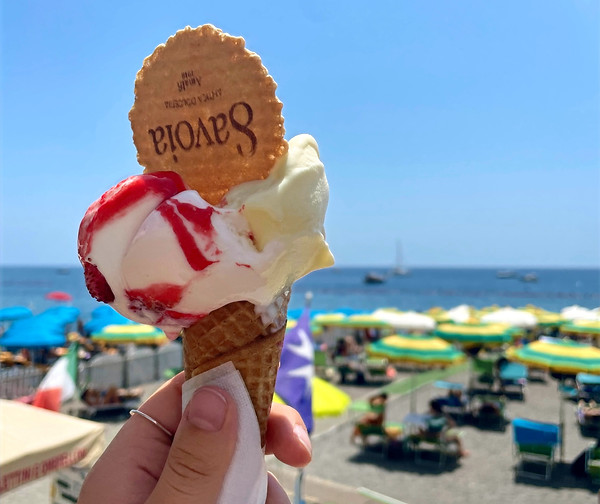Italy is a bucket-list, paradise destination for many and is known for its beautiful, historic cities, amazing views, and of course, delicious food. In May 2022, after believing I wouldn't study abroad in college for various reasons (I'm looking at you, COVID), I had the amazing opportunity to visit.
I spent six weeks in a tiny town called Urbino in the Marche region of central Italy. Then, I traveled around the country for another two weeks before tearfully heading home. It was a life-changing trip, leaving me a different, more confident person with a passion for discovering the world. Besides the mushy gushy personal developments, I experienced many logistical things that I wasn’t expecting. Here I will list what I think anyone studying abroad or traveling in Italy should know.
What to Pack:
Sun and Heat Protection
As I was in Italy during the summer, I can’t speak about packing for any other season. But summers in Italy are definitely killer. Make sure to pack:
-
light clothing
-
sunscreen
-
sunglasses
-
a water bottle
-
and a hat (not a baseball hat, though. That’s a dead giveaway that you’re a tourist.)
I would also recommend bringing a handheld fan for when you’re out in the heat and a mini electrical fan if you don’t have air conditioning where you’re staying.
TIP: My water bottle was my saving grace, as water is a much less common beverage in Italy than in America, and restaurants will charge you for it.
Health and Medicine
Depending on how long you’re staying, bring necessary health and medical supplies. This is what I used:
-
Ibuprofen
-
Benedryl (topical and oral)
-
cold medicine, night and day
-
tissues
-
aloe vera
-
bandaids
-
Tums
-
Melatonin
-
masks (KN-95)
-
other hygiene products
If you require:
-
prescription medicines
-
inhalers
-
allergy meds
-
birth control
-
or any other important medications
Make sure to contact your doctor or pharmacist to ask for extras for the amount of time you’ll be away. This obviously does not just apply to Italy travels, but it is something I didn’t think about until a few days before I left. Depending on your pharmacy and/or insurance company, it might take a bit longer to get extra medications for you, so I would ask earlier rather than later.
TIP: Keep your medications in their original bottles or packages in case Customs has any questions. I also printed out my doctor’s note explaining the prescription medications I was bringing. I didn’t end up having any trouble with my medications, but I would rather be safe than sorry.
Bags
I found it was helpful to have both:
-
a cross-body purse
-
and a small backpack
If I was going out for a meal, a drink, or a few hours, my purse was enough. For class, beach days, or long day trips, I preferred to have my backpack for more storage. I really liked this bag I got before the trip from Amazon. It looks small but it fits my computer, water bottle, camera, notebook, wallet, etc.
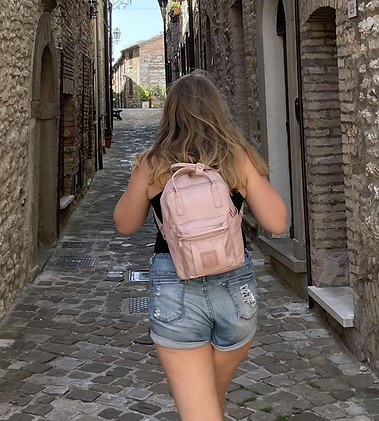
Adaptor
Italy requires a Type L power adaptor, so don’t forget to bring one of those. I also found it helpful to bring a power strip, so I could use all of my regular cords and power blocks with just one Type L plug. If you are traveling somewhere else, make sure to figure out what kind of charging adaptor is required.
Sleep Aids
Just like any city, the streets are loud. But with how late Italians stay out (usually between 2-4 am each night), it can be difficult to tune out the street noise. If you are a light sleeper, consider bringing a sleep mask and/or earplugs.
Paperwork and Identification
Along with the originals, I brought two photocopies of my
-
passport
-
driver's liscense
-
health insurance
I kept the originals and one photocopy of each in a safe place in my dorm room and carried the other copies with me. When I was traveling around, I kept the originals on me, in an inside pocket in my bag so no one could easily reach them.
The university dorm in Urbino required a copy of my passport in order for me to live there. Be ready for the place you are staying (long and short term) to request to take a copy of your passport for their records.
TIP: While travelling around Europe, trains, hotels, and Airbnbs require you to show them your passports before using their service. It is the law in Italy that everyone carries identification and it is needed to travel and spend the night places.
Travel:
The biggest advice I have is to download the apps Trainline and Moovit.
-
Trainline lets you purchase tickets for all the brands of trains and buses in one place.
-
Moovit is a great tool to find the cheapest and most efficient ways to travel from one place to another, especially within one city. It also gives step-by-step instructions for walking to a bus, train, or Metro station and shows you a map of all of the stops. Using Moovit was the biggest reason that I didn’t get too lost while traveling around the country.
At bus and train stations, you need to pay to use the bathroom, usually 1€. Most trains, especially the ones that travel across the country, have bathrooms on board, so if possible, I avoided paying by using those.
Tabacchi shops sell bus and Metro tickets, so look for the blue “T” signs when you’re looking to take a trip. It is also a good place to ask for directions or travel assistance, assuming they speak a little English.
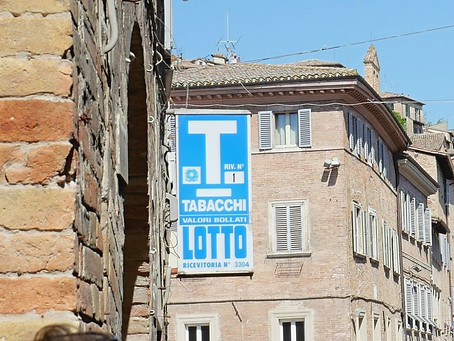
This is not as common in more touristy areas, but in smaller cities, buses and trains might have limited hours on Sundays. This includes pickup and dropoffs, as well as ticket offices. Be aware of this if you need to get somewhere on a Sunday and make sure to plan ahead.
Speaking of closed ticket offices, you can buy a bus ticket on most buses. The buses have machines that you can purchase a ticket at, as well as verify your ticket as you get on the bus.
The buses have auditors that will hop on at a stop and ask to see everyone’s ticket, so be sure to always purchase one. As I don’t speak Italian, I’m not exactly sure what they are saying, but from what I gathered, it’s along the lines of “show us your ticket or hop off!”
Cities require any place you stay as a tourist (hotels, Airbnbs, hostels, etc.) to charge a tourist tax. This fee is usually around 5€ per-person per-night. Sometimes it is added onto your bill, sometimes they accept cash or card, but be prepared to be charged this tax.
Food and Drink:
TIP: One of the largest parts of Italian culture is their food and drink. I would recommend researching the Italian food customs, norms, and traditions before arriving, just to brief yourself on what is expected and how you can respect the culture as best you can.
Coperto
Restaurants charge a coperto, which is a per-person fee, like a cover charge. If the coperto is 1.50€ and there are 4 people eating, there will be a 6€ charge on the bill. This charge is usually between 1€ and 3€ and covers the bread and the use of the tablecloth and utensils. This is also used instead of tipping, as tips are not common nor expected in Italy.
Bread and Water
Something different about Italian restaurants as opposed to American restaurants is that water and bread are not complimentary. As mentioned above, the first bread basket is often covered by the coperto, but any additional baskets will be added to your bill. Water will come out in bottles and you pay for each bottle. Unlike America, where you get a glass or pitcher of water immediately and it continues to be filled for free, you need to pay for each bottle of water you order.
In America, bread baskets are known as appetizers and are often eaten before the main dishes are served. In Italy, the bread baskets come out before the dishes, but they are not meant to be a pre-dinner snack. Servers have said they can tell my party was American because we scarfed down the bread immediately. There are many bread basket rules, but if you're starving and you don’t mind paying for another basket (or three), just eat the bread.
Crema Caffè
Other than the obvious pizza, wine, gelato, and pasta, Crema Caffè is, in my opinion, the best thing that can be consumed in Italy. I describe it as a Wendy's Frosty, but coffee flavored. And as Italy doesn't serve many beverages cold, Crema Caffè is hands-down the most refreshing beverage to order on a hot summer day. Or a cold winter night. Best beverage, period.
Rules
In addition to the bread rules, there are many food rules in Italy. Some of them don’t make much sense to a visitor, like no Cappuccinos after 10am or no sodas with meals, but Italians are very particular with their food. Most servers won’t say no if you ask for grated cheese for your seafood dish or white wine with steak, but they will seem disappointed. Again, if you feel so inclined, eat and drink what you want, but just beware that you may get some funny looks, as you are breaking the deeply set rules of Italian eating culture.
Allergies
Learn the words for your dietary restrictions and allergies before you go abroad. The most often times I needed to speak Italian was while I was ordering food and drink and usually, I could just point to the menu. But if you have a food allergy or restriction, it is good to have those words handy to keep yourself safe. Even better, getting a card that lists your allergies or restrictions can be the easiest and most efficient way to communicate with the entire restaurant staff.
Apertivo
Possibly one of my favorite parts of any day I spent in Italy is apertivo. In the late afternoons and early evenings, before dinner (which usually begins 7:30 pm or later), Italians gather in bars to unwind after a day's work. This social gathering usually includes a drink, a common choice being an Aperol Spritz, as well as a platter of bread, meat, cheese, olives, chips, nuts, and other finger foods.
Etiquitte
One of the things I never quite understood was restaurant etiquette. Not the eating part, but the ordering and paying part. At most places, especially with outdoor seating, you can just sit down and a server will come out to you. However, sometimes you will sit down and no one will come, so you will have to go in to order (usually breakfast places).
Afterward, they will bring your check out to you, but sometimes you pay them directly and sometimes you are asked to go inside and pay the host. It is a confusing and sometimes awkward interaction, especially with the language barrier. If you keep your eyes peeled and watch what those around you do, you can usually get a sense of what that particular restaurant expects.
Ordering at Italian restaurants is different from America as well. After getting the menu, the server will not return until all party members have closed their menus. It took many meals to figure out why our servers weren’t coming back to us, until we realized it was because we were still looking at our menus. Also, once your food comes out, unlike American servers, they will not check on you or ask if you want more wine, dessert, the bill, etc. until you wave them over. The servers walk around and are always happy to help, but they don't want to interrupt your meal and conversations until you call them over.
It is uncommon and considered disrespectful to ask your server to split the bill among your party. It isn't a part of their job to handle your group's finances. I'd suggest bringing cash and being prepared to Venmo. Otherwise, get ready to receive dirty looks and exasperated sighs.
Food Culture
As food is such an important part of the Italian culture, there is no rush to finish their meals. Italians love to take things slow and enjoy their conversations, which is a beautiful thing I’d come to appreciate. However, when I first arrived, I was shocked at how long meals took to complete. Italians sit and chat with all their food. Whether it be a morning cappuccino, an afternoon apertivo, or a starlit dinner, there is no rush for meals to be completed. I think this lifestyle of slowing down and enjoying the people and food is one of the things that I took with me back to America, but be aware that it is a hard adjustment. There aren’t many to-go food or coffee places, so if you have somewhere to be, account in extra time for sitting down to eat.
In Italy, you mostly eat Italian food. This may seem obvious and a silly observation, but coming from America, it was a bit of a culture shock to see such little variety of food options. In small towns, the restaurants serve pasta, pizza, fish, meat, pastries, and gelato. If you’re lucky, there might be a falafel, poke bowl, or chicken place. For 95% of your meals, you're eating Italian. Of course, you are going abroad to eat the way that culture does, but it is a hard adjustment to go from so many options and cuisines to one, especially if you are staying for a while. By the end of our time in Italy, all my peers and I were speaking of all the foods we were excited to eat; mostly Chipotle, Chick-fil-a, and Chinese food.
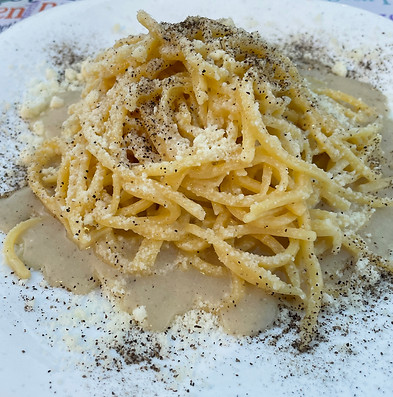
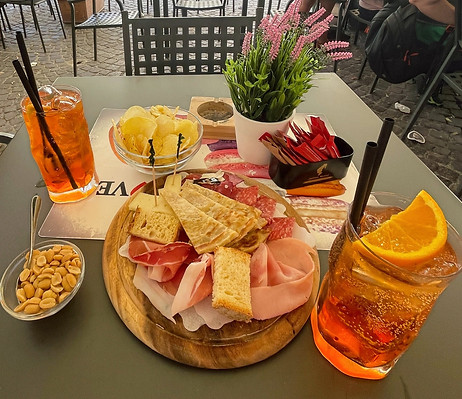
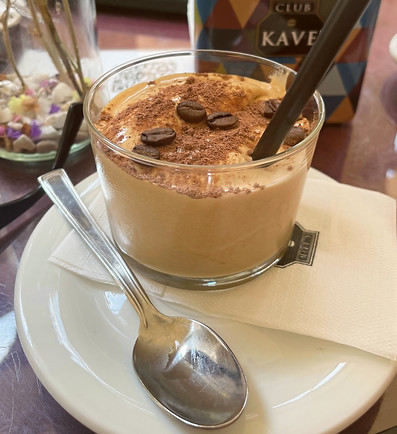
Night Life
As a college student in America, it is not uncommon for me to stay out late. But “late” takes a whole new meaning in Italy. Especially in a university town like Urbino, people stayed out regularly until 4 am or later. Once I was catching an early bus at 7:30 am and people were still out from the night before! So be prepared to be teased by the locals if you go to bed at a decent hour.
University students in Italy have their big going-out nights on Thursdays. If you are looking to make Italian friends and are staying near a university, going out on Thursdays is a good bet. Fridays are more chill, usually for smaller house get-togethers. More people go out on Saturdays, but not nearly as many as Thursdays. Of course, just like in most American college towns, Italian students go out every night, so there is no lack of nightlife.
Money
One of the countless things I really liked and found interesting about Italy was the frequent use of coins. It seems strange, but I loved being able to pay with 1€ and 2€ coins.
On top of the weird amount of fun I had with the coins, many shops and restaurants, especially smaller ones, get charged a processing fee for credit cards. Cash is much appreciated and sometimes gets you a discount. A good rule of thumb I found is that all purchases less than 10€ should be paid in cash. Also, some places don’t accept card, so make sure you always carry cash.
MasterCard and Visas are widely accepted in Italy. American Express is less common and Discover is not accepted, so plan accordingly depending on what kind of credit card you may have.
The exchange rate for withdrawing cash depends on where the ATM is located. I found that ATMs in airports, train and bus stations, and near touristy areas have a much higher exchange rate than in a small town or less busy area. These rates can end up costing you a lot of money, so look for ATMs in less frequented areas.
Notify your bank, credit card company, etc. that you will be abroad. You can usually do this online and this will prevent your card or bank account from being frozen because of foreign activity.
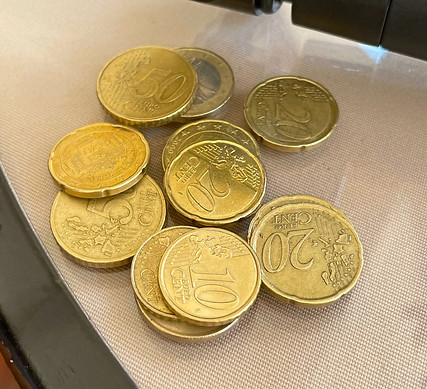
Random Everyday Things
Tabacchi shops are an all-encompassing place that you need to know about. Again, you can spot these stores everywhere by the “T” signs. A tabacchi shop is like a convenience store that has tobacco (obviously), as well as a combination of snacks, drinks, souvenirs, postcards and stamps, and more. Depending on the store, it will sell different things.
Speaking of postcards, if you are wanting to mail anything, you should be aware of a few things. You will see many red Poste Italiane boxes around. These are only for national mail. Meaning if you are trying to mail anywhere outside of Italy, you need to use a blue Poste box. You can also always go to a local Poste office, though I would recommend buying your stamps at a tabacchi shop for better convenience and price.
Rawpixel.com
Sundays are considered much more of a “day of rest” than in America, as much of Italy is Catholic. Many stores, restaurants, and transportation offices have limited hours or are closed on Sundays. Make sure to check a place’s hours before you plan on going somewhere on Sundays.
In smaller and less touristy cities, pausa takes place every day from around 1 pm to 3:30 pm. This is a time when most businesses will close for lunch, family time, and a rest period. This is definitely something that is difficult to get used to and we would often make plans to go shopping, out to lunch, etc. before remembering that everything would be closed for a few hours.
There are water spouts around most cities in Italy that I was suspicious of at first, but the water is clean and delicious. Sink tap water is good too, so make sure you are staying hydrated, especially in the summer.
DOWNLOAD GOOGLE TRANSLATE! I not only had the app on my phone but I downloaded Italian on the app so I could translate English to Italian without using Wifi or data. The app has a photo feature, which was super helpful to translate signs and menus.
The driving culture in Italy is so different from America that it was shocking. Drivers are very aggressive and bold in their merging and turns. Drivers seem to be unafraid of going fast, even through the common round-a-bouts. Additionally, pedestrians are not as protected as they are in America, as vehicles are not going to stop for you. If you need to cross a street, you just need to commit and walk forward confidently. From what I saw, drivers are safe and experienced, but follow different road norms and etiquette than what I was used to.
If you are visiting the beach, there are a lot of protocols to follow that I was definitely not expecting. Any beach that has rows of chairs and umbrellas is private and you need to pay to use the equipment. If you try to sit down without paying, you will quickly be told you are doing something wrong. These private beaches are expensive, usually around 10-20€ per chair and per umbrella for the day or a half-day.
The beach bathrooms are free and are marked as WC (water closet). There is usually a WC key hanging near the cashier that you can grab to use the bathroom. You can also use the changing rooms if you have purchased a chair/ umbrella.

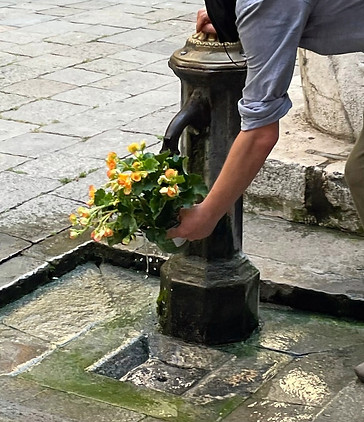
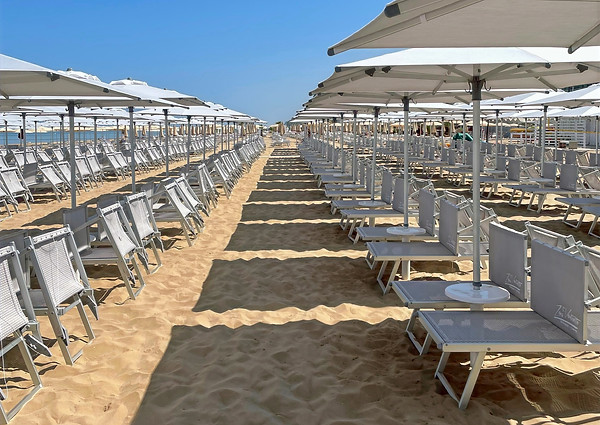
Conclusion
Whether you are studying abroad in Italy or elsewhere, there is no limit to how many shocking and interesting things you will encounter. No matter how many lists and articles you read, you will get to discover so much that nothing could have prepared you for. Which is both the most terrifying and most exciting part of your time abroad.
I grew so much during my time abroad because I was thrown into a culture and situations that I had no prior knowledge about. Having to navigate the unknown allows you to leave stronger and more confident. Trust that pushing yourself outside of your comfort zone is the best way to find who you are and what you love about the world.
My last pieces of advice:
-
Have fun
-
Stay aware of your surroundings to keep yourself safe
-
Eat gelato at least once a day because there is truly nothing like it in America.
